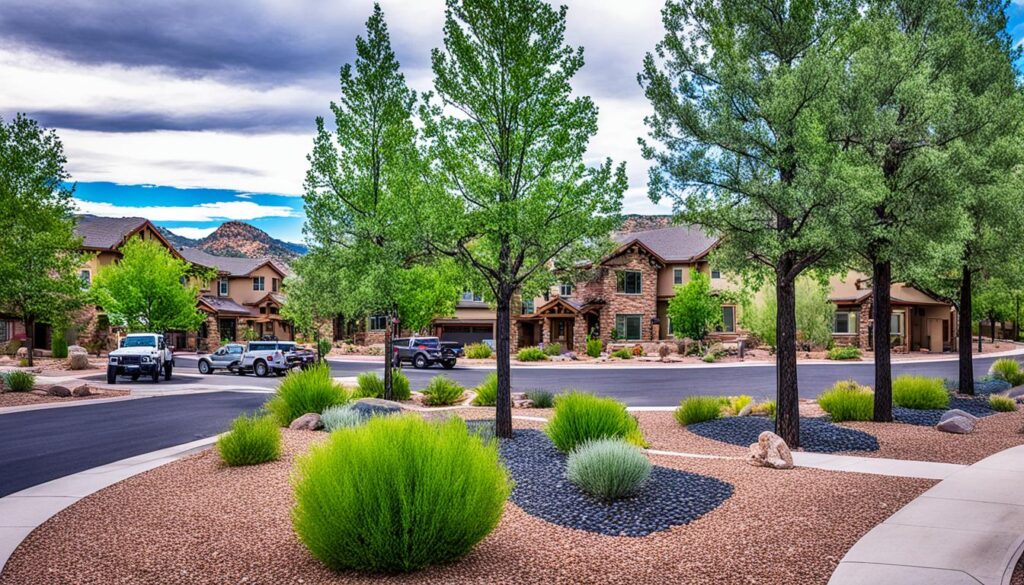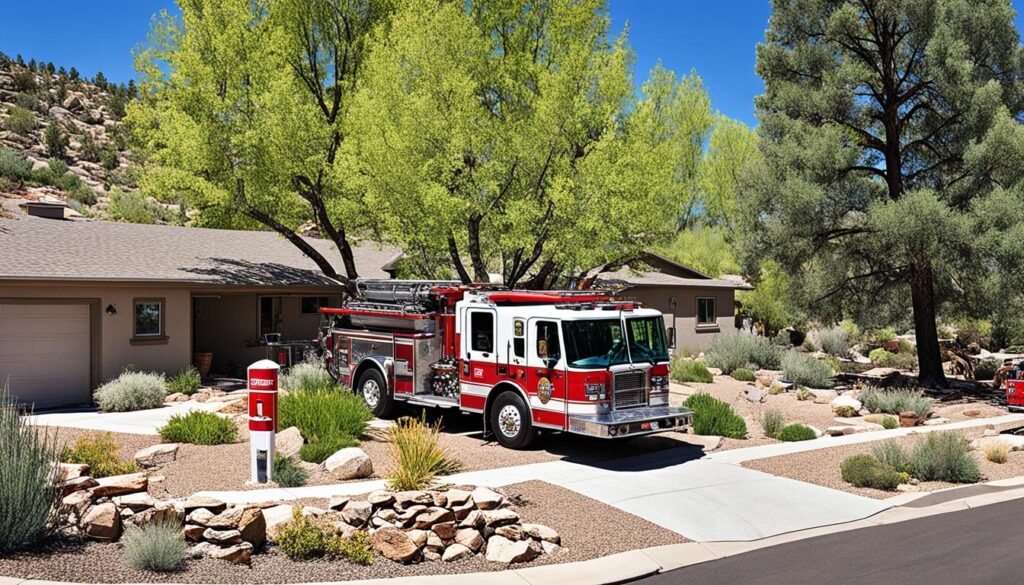
In Prescott, AZ, wildfires pose a big threat to communities. The Firewise program helps by certifying communities that meet certain criteria. Communities must create a safe, fire-resistant space to reduce wildfire impact.
This article will talk about what makes a community Firewise in Prescott, AZ. Knowing these rules is key to protecting homes from wildfires.
Key Takeaways:
- The Firewise program aims to reduce the risk of wildfire damage in communities.
- Communities must meet specific guidelines and requirements to achieve Firewise certification.
- Vegetation management, building materials, and emergency preparedness are among the key criteria.
- Proper access roads and community-wide preparedness are crucial for Firewise certification.
- Obtaining Firewise certification enhances the safety and resilience of communities in Prescott, AZ.

Firewise Program Overview
The Firewise program focuses on community safety and reducing wildfire risks. It gives communities guidelines to make them more resilient against wildfires. By following these guidelines, communities protect both people and properties.
It encourages communities to take steps that lower the chance of wildfire damage. These include managing vegetation, using fire-resistant materials, ensuring access roads are good, and preparing for emergencies.
By following Firewise guidelines, communities can lessen the impact of wildfires. It helps them create safer environments and take preventive actions.
Firewise aims to protect individual homes and entire communities. It suggests managing vegetation, choosing fire-resistant materials, ensuring access to emergency vehicles, and making emergency plans. These actions significantly lower the risk to lives and properties.
Benefits of the Firewise Program
- Enhanced community safety and resilience against wildfires
- Reduced risk of property damage
- Increased awareness and preparedness for wildfire incidents
- Access to resources and support from the Firewise program
- Potential insurance incentives for Firewise-certified communities
The Firewise program benefits communities in Prescott, AZ, and elsewhere. By using its guidelines, communities actively protect against wildfires. This ensures the safety and well-being of their residents.
| Firewise Program Criteria | Community Safety |
|---|---|
| Vegetation management | Promotes safe and responsible vegetation practices to reduce the risk of wildfires spreading |
| Building materials and design | Encourages the use of fire-resistant materials and construction techniques to enhance property resilience |
| Access and emergency preparedness | Elevates the importance of maintaining access roads and developing comprehensive emergency plans |
Firewise Guidelines and Requirements
Communities aiming for Firewise certification need to follow certain rules. These include managing plants, choosing safe building materials, maintaining roads, and being ready for emergencies. Together, these steps help guard against wildfires.
Vegetation Management
Managing plants is key to Firewise success. This means removing risky brush near buildings and choosing plants that resist fire. It’s all about keeping the area safe.
Building Materials and Design
To meet Firewise standards, choosing safe building materials is crucial. Communities are encouraged to use materials and designs that resist fire. This includes special roofs, screens, and walls that fire can’t easily damage.
Access and Emergency Preparedness
Good access and preparedness are vital. Communities need roads that let emergency teams get everywhere easily. They also need strong plans for wildfire emergencies, to keep everyone safe.
Communities that follow Firewise rules work to be safer and stronger against wildfires. This involves smart plant management, secure buildings, and good emergency plans. By doing this, they better protect their homes and people.
| Guidelines | Requirements |
|---|---|
| Vegetation Management | Implement vegetation clearing and use fire-resistant plants. |
| Building Materials | Promote the use of fire-resistant construction materials and techniques. |
| Access Roads | Maintain well-designed and accessible access roads for emergency vehicles. |
| Emergency Preparedness | Establish robust emergency plans and promote community-wide preparedness. |

Vegetation Management
Managing vegetation is key in the Firewise program. It helps communities lower the chance of wildfire damage. This is done by correctly handling the plants around homes and buildings.
There are many steps to manage plants safely. The goal is to make a safe space that stops fires from spreading. First, getting rid of brush and dead plants is crucial. These items can catch fire easily.
Next, it’s important to keep the area near buildings clear. Make sure things like wood piles and thick bushes aren’t too close to structures. This helps prevent fires from reaching homes.
Choosing plants that resist fire is another smart move. Some plants don’t burn as quickly and can protect against fires. Adding these plants to the landscape creates a safety zone around areas.
Good plant management does more than just stop fires near buildings. It makes the whole community safer. This practice is vital for meeting Firewise rules and getting certified. Take a look at this impressive piece.
Building Materials and Design
Choosing the right building materials and design is key for Firewise certification. Communities must use fire-resistant materials and construction techniques. This makes buildings better at withstanding wildfires. By doing this for both new builds and renovations, the risk of fire damage drops a lot.
Using ignition-resistant roofing is vital for Firewise buildings. Materials like metal, tile, or high-rated asphalt shingles protect against fire. Fire-resistant window screens also help. They stop embers from getting inside, which lowers the chance of fires starting.
For exterior walls, it’s best to use materials that fire can’t easily penetrate. Fiber cement siding, masonry, and stucco are top choices. They resist fire better than wood or vinyl. Using these materials makes homes and commercial buildings more fireproof.
Firewise Design Principles
Firewise communities also need to stick to certain design principles. These rules help lessen fire risks and protect buildings. Important steps include:
- Designing homes with good space between them and nearby plants.
- Picking materials for decks and patios that won’t catch fire easily.
- Choosing landscaping that limits fire fuel.
- Putting spark arresters on chimneys and stovepipes to catch embers.
Following these design principles during planning and building makes Firewise communities safer. They create places that focus on safety and protection from wildfires.

Access and Emergency Preparedness
Having good access and being ready for emergencies is key to the Firewise criteria. When a wildfire happens, it’s vital to get to the impacted areas quickly and safely. This helps keep people safe and lets emergency teams do their job well.
Access roads are crucial for emergency vehicles to get to homes. These roads must be clear, wide enough, and properly marked. Keeping them free from plants and rubbish is key to avoiding any delay that could risk lives and homes.
Getting ready for wildfires is also critical for communities. This means having strong emergency plans. These plans should have escape paths, meeting spots, and ways to talk during a crisis. Practice runs and teaching people what to do are important for a good response.
It’s vital for everyone in the community to work together on emergency plans. This means having meetings and workshops to teach about fire safety and what to do if a wildfire comes close. Knowing how to spot and report fires early is part of this.
To get even better at handling emergencies, communities can work with local fire crews and disaster agencies. This helps share knowledge and resources, and get advice from experts.
By focusing on clear access roads and getting ready for wildfires, communities can be more prepared. These steps keep people safe and help the area bounce back quicker if a fire happens.
Firewise Certification Process in Prescott AZ
Getting Firewise certification in Prescott, AZ is key for community safety against wildfires. It involves following a few important steps. This makes the area safer and more resilient.
The first thing to do is assess the community for fire hazards. This helps figure out what risks are there. Then, it’s easier to plan how to lower those risks.
After knowing the risks, it’s time to make a plan. This plan includes how to deal with plants, what building materials to use, how to make roads safer, and how to prepare for emergencies.
With a plan ready, the next step is to act on it. This means cleaning up the community, reducing fire fuels, and teaching everyone about fire safety. These efforts help meet Firewise’s strict rules.
Being Firewise certified shows Prescott, AZ communities care about stopping wildfires. It means homes and people are safer. Plus, it opens doors to helpful resources, money, and support from folks who are also Firewise certified.
Yavapai Landscaping Prescott offers free quotations for Prescott and its nearby localities for landscaping and tree services. These include tree removal, trimming, stump grinding, land clearance, storm clean up, and emergency tree service
